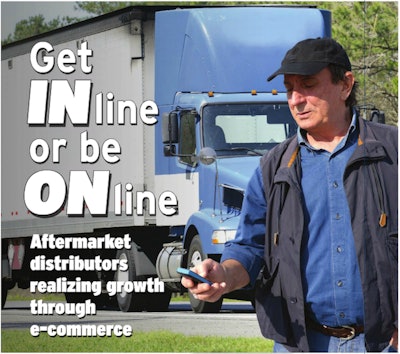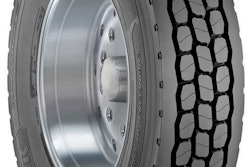The following comes from the March 2017 issue of Truck Parts & Service. To read a digital version of the magazine, please click the image below.

“Doing business as usual” just can’t be the standard any longer. That’s the message resonating throughout the aftermarket world.
As the widespread use of technology creeps into our daily lives more and more, the aftermarket can no longer turn its head and cover its ears. A new sales e-commerce channel is forming, and it’s time for aftermarket distributors to take advantage of the many opportunities this creates.
According to a recently released joint survey conducted by MacKay & Company and online distributor FinditParts, 55 percent of respondents have already purchased a Class 6-8 truck or trailer part online.
Additionally, of the 45 percent of respondents who had never purchased a heavy-duty part online, nearly half of those (47 percent), said they would consider doing so in the future.
The survey found the most important reasons for purchasing parts online were affordability/price (75 percent), availability of parts (69 percent) and convenience (62 percent).
The primary reasons given for not purchasing parts online were long delivery/wait times (50 percent), desire/need to speak with a salesperson (47 percent) and loyalty to an existing distributor (39 percent).
“The results of our initial survey validate the fact that buying online is safe, efficient and affordable, and is often meeting the delivery times required to satisfy the needs of most buyers,” says David Seewack, CEO of FinditParts.
The two groups plan to release a larger, more comprehensive look at online buying later this year.
“Through our initial survey, we have just scratched the surface of the online heavy-duty parts buying topics and issues,” says John Blodgett, vice president sales and marketing at MacKay & Company.
If that deeper dive into the habits of online buyers produces the expected outlook, distributors will get to see where they stand in an ever-changing marketplace.
What they are likely to find is that e-commerce is a much needed if not must-have tool in today’s market. With a major shift in the demographics of buyers, e-commerce opens new opportunities to customers looking to buy online.
“As we all know, the demographic of the end user is changing,” says Jeff Paul, director of marketing for VIPAR Heavy Duty. “There’s a younger generation that doesn’t do business the old way. They want to use e-commerce as their primary source of doing business.”
E-commerce can be an efficient way of doing business. Distributors, suppliers and end users are all able to access products in a reliable, straight-forward format that cuts out a great deal of the confusion about product availability and product information, if the website is done correctly.
VIPAR Heavy Duty launched VIProParts.com in 2015 as a way to help end users purchase heavy-duty truck parts. The website is a full-featured online store where end users can find the industry’s leading brands of aftermarket products, which are then delivered through the VIPAR Heavy Duty network of participating distributors.
Paul says the organization recognized a shift in the buying habits of some truck parts purchasers and wanted to find a way to connect customers with the group’s distributors.
“One of the main reasons we launched VIProParts.com was to make sure that our distributors could connect with the customers,” he says. “We designed the site with product search capabilities to enable buyers to shop and purchase parts easily when it best suits them.”
When visitors enter VIProParts.com, they are prompted to select a local participating distributor to fulfill their order. Specific catalog information for that distributor is displayed to end users, as well as location and technical support contact information providing the expertise of a local parts specialist when needed. The order, payment and delivery are then fulfilled through that local distributor with multiple shipping and delivery options.
“Local expertise plays an important role in the aftermarket industry,” Paul says. “People feel comfortable shopping in the areas they know. Through this site, the orders are filled by local distributors. This is similar to the way Amazon works as far as having the orders filled through different distributors.”
Paul says the site has been a learning process over the past couple of years, but it’s a good source of connecting distributors and customers.
Bill Burns, chief operating officer of HDA Truck Pride, says his organization uses an online library of all the images of the products that their vendors offer.Burns says there is a “big monster out there called Amazon” and distributors have to be prepared to offer the accessibility that sources like that offer.
“We have to be able to assist our members,” he says.
There is an ongoing initiative aimed at helping HDA Truck Pride members with an e-commerce platform, Burns says.
Dana Nevins, CEO at Web Shop Manager, produces comprehensive web-sites for businesses in several industries, and has created more than 300 for the automotive industry alone, including the heavy-duty aftermarket. He says the heavy-duty market is one that is ready to “grow exponentially.”
Nevins says aftermarket businesses can thrive by starting small, focusing on their strengths and developing a website that caters to their existing customer base.For distributors looking to grow or enhance their e-commerce platforms, Nevins says being selective and choosing the right system is key.
“This is a new frontier for a lot of people in the industry,” he says. “It’s not a bad thing to look at things as ‘if it ain’t broke, don’t fix it.’ But, at the same time, you have to change with the times.”
One issue that Nevins sees working with folks just entering the e-commerce business is that many feel as if they have to go “all in.”
“A lot of them think ‘I have to do everything just right’ and they build it up in their head. But, when you set out to run a marathon, you don’t start by running a marathon. You start by walking or jogging in the evenings and you build your way up,” he says.
He adds that “going all in” in e-commerce is essentially starting a new business.
“It is better to start small and add components and build on the business,” Nevins says. “It may be as simple as training one tech to help expand your services initially. It allows businesses and business owners to adapt quicker and then you can add to it later.”
Distributors may want to start by adding a certain number of products online, such as 100, 200 or 500.
“The advantage to having your top selling products online is that it makes it available to the customer 24/7, they can order them anytime,” Nevins says.
The instant access to products is an important part of any business in today’s market. No distributor or supplier wants to lose a customer’s business simply because it’s easier to order the product somewhere else.
 An online ordering option allows customers during the evening and have your team stock and deliver the parts the next day.
An online ordering option allows customers during the evening and have your team stock and deliver the parts the next day.Websites can be designed to incorporate technology, branding and design, product data and to hit the right marketing channels.Nevins says that many successful e-commerce websites demonstrate a specialty or an “expertise” in a certain product. He also says that using product catalogs and tech articles to attract customers to a site are helpful.
“Having product data even without a catalog is a good first step in building a successful e-commerce site,” Nevins says.
He even encouraged small distributors to test the waters by using sites such as eBay to gain familiarity with the process.
For some, e-commerce expansions have been an ongoing concept for quite some time. For example, Consolidated Metco (ConMet) recently rolled out a new web-site platform that includes the use of videos to help provide end users with even more useful information on the product needed. On its site, one of the videos de-picts the benefits of replacing wheel ends with preset aftermarket hub assemblies as opposed to rebuilding them.
“We have found that the use of videos is an ideal way of helping explain a message to the customers in a clear, hands-on way,” says ConMet’s Senior Marketing Manager Mark Jorgensen.
The company’s website shows where distributors are located throughout North America so end users can more easily access the locations where their products may be purchased.
ConMet even took its technological branding to a new level and released a free app that can be used on several digital platforms, including tablets and smart phones.
“The app is beneficial because some-one can look up the part number they need and where the nearest distributor is located even if they are stranded roadside somewhere,” Jorgensen says.
Companies also can build websites as informational platform tools. That’s what drive-line maker Neapco did in January, releasing a new website that tells more about its product line than previous platforms did.
“This website shows our products and describes them in a better way,” says Cal Settle, Neapco market research and publications manager for the driveline aftermarket group.
Still, others take their digital efforts in an altogether different direction. For example, Tectran and Gray Manufacturing place a catalog inventory of their products online.
Whether a site allows full functionality in purchasing items or is best used for informational purposes, most all agree that technology and e-commerce are vital parts of the industry.
“You have to stay up to speed or you’ll get left behind,” Nevins says.
Paul agrees. “Business as we know it has changed. E-commerce will continue to play a vital role in our distributors’ way of doing business as we move forward.”









